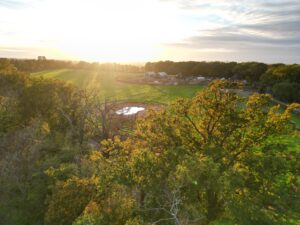If you have ivy on trees in your landscape, you’ll want to keep it in check. Although many property owners and landscapers use ivy as a groundcover, it is often problematic. It is not native to North America. As such, many species are aggressively invasive and displace native species. With no natural controls, it easily overruns intended boundaries. In North America, the most common culprits are English (Hedera helix) Irish, or Atlantic ivy (Hedera hibernica). When ivy grows on trees, particularly over the root area, its presence becomes a tree health and safety concern.

Why Ivy on Tree Roots is a Problem
When growing near or over roots, ivy can hide serious issues. One such concern is girdling roots. These are roots that wrap around the trunk, restricting the movement of water and nutrients. Root problems are a leading cause of tree loss. With this in mind, an arborist must have a clear view of the root collar and flare to properly inspect a tree. Unfortunately, ivy often obstructs that view, making a proper check challenging.
Tree Stability and Structural Concerns
Beyond issues with the roots, the presence of ivy can result in other structural concerns. Vines growing up the trunk can girdle branches and block sunlight. This thick coverage also conceals defects and can keep an arborist from identifying potential hazards. Another problem is that ivy adds considerable weight and wind resistance in a canopy. Branches may break more easily. Plus, because ivy is evergreen, trees that would normally be bare during winter suffer extra stress from rain and wind.
Practical Management of Ivy
Eradicating ivy entirely is the best scenario for trees and the native environment. However, ivy removal can be dangerous for the tree and for the individual undertaking the task. It’s a good idea to consult a Certified Arborist on the proper course of action.
In situations where complete removal is not desired, there are practices to help contain ivy to limit the negative impact. First, remove it from tree trunks and pull it back at least three feet from the base of a tree. This will mitigate the weight, moisture and wind resistance issues associated with ivy. Additionally, it will make the structural roots visible for inspection. Beyond addressing ivy around the roots and trunk, whenever possible, prevent it from climbing on vertical surfaces. Ivy produces seed only when it is growing vertically. That means a well-maintained groundcover is far less likely to provide seed for invasion of natural areas than ivy that is climbing walls or trees.



